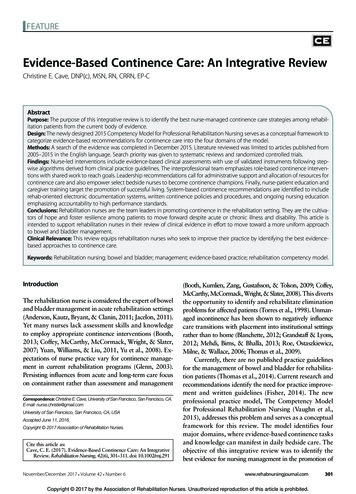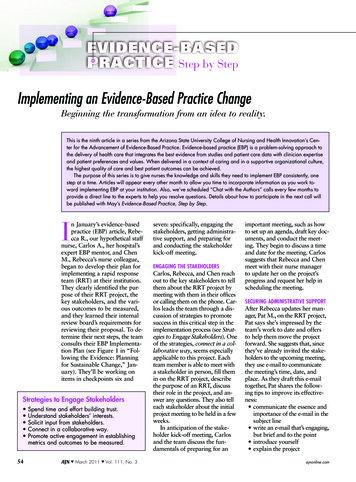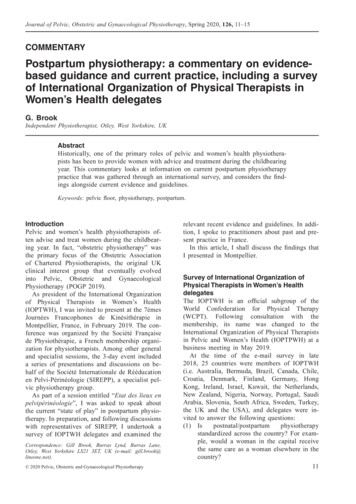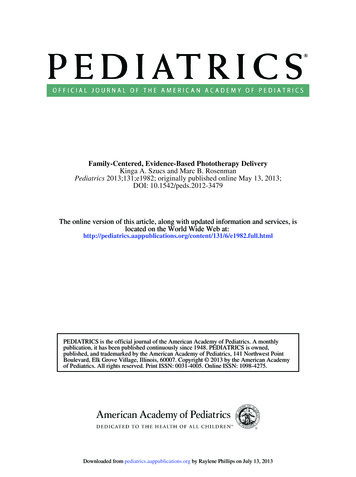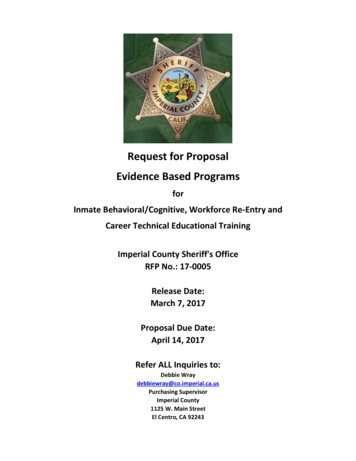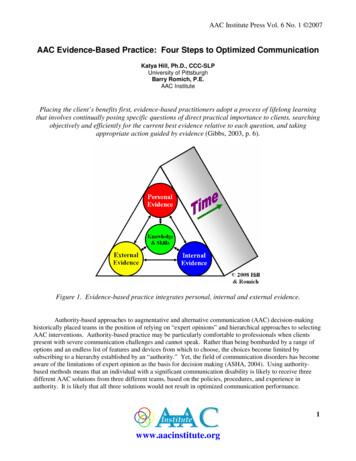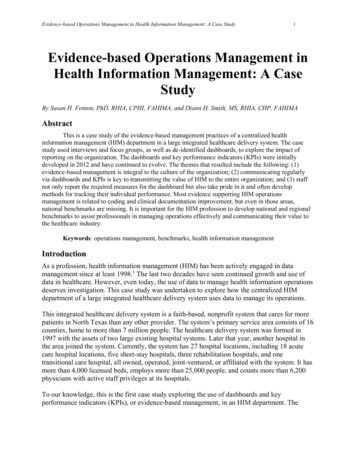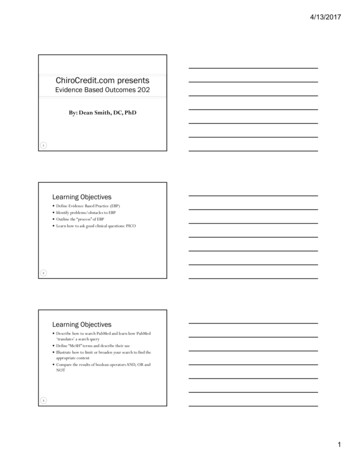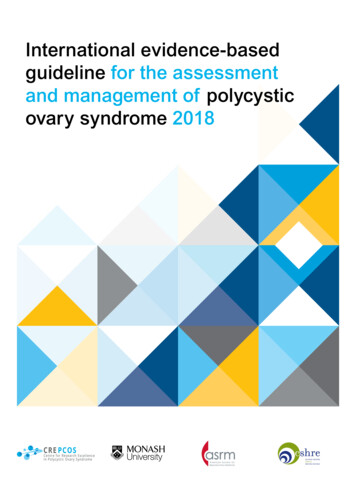
Transcription
November 2016Evidence-Based Practices in School ImprovementFive Profiles of Promising PracticesThese profiles were prepared by AEM Corporation under contract ED-ODS-12-A-0019/0021 to the U.S. Department of Education (Department), Office of StateSupport, in the Office of Elementary and Secondary Education. This series of profiles does not necessarily reflect the views or policies of the Department. TheDepartment has not independently verified the content of these profiles and does not guarantee accuracy or completeness. These materials may contain theviews and recommendations of various subject matter experts as well as hypertext links, contact addresses, and websites to information created and maintainedby other public and private organizations. The inclusion of the information in these profiles is not intended to reflect a determination by the Department that anyactivity, product, program, intervention, model, or service mentioned may be supported with Federal funds. The Department has not determined that thepractices in these profiles are effective and does not endorse or recommend any organization, product, or program mentioned in these resources or any viewsexpressed in these profiles; the practices described herein are provided merely for informational purposes.
Contents Project Overview Purpose of the ProfilesConceptual FrameworkGuiding QuestionsMethodologyProfiled SitesOrganization of the Site ProfileProfile of Wisconsin Department of Public Instruction: Positive BehavioralIntervention SupportProfile of Iredell-Statesville Schools: Innovative Methods for PersonalizingAcademics, Complemented by TechnologyProfile of San Francisco Unified School District: The Superintendent’s ZoneProfile of IDEA Public Schools: Catalyst Critical Student InterventionProfile of IDEA Public Schools: Critical Student InterventionClick on an underlined item to go directly to that section.Slide 2
Evidence-Based Practices in School ImprovementPROJECT OVERVIEWSlide 3
Project Overview:Purpose of the ProfilesThe purpose of these profiles is to demonstrate what evidence-based decisionmaking looks like in practice. By highlighting this process, these profiles will helpto guide others with important points to consider as they use evidence to selectand implement interventions to improve student outcomes.This project identified four sites to profile (states and districts) that promotepromising practices in the selection and implementation of evidence-basedinterventions to improve student and teacher outcomes. Among the promisingpractices highlighted are examples of how in 2009-2012 these sites usedevidence to select interventions that have the potential to align to the newstandards for levels of evidence as described in ESSA. The profiles document thepromising practices, successes, challenges, and lessons learned related to theimplementation of evidence-based practices in these sites.Slide 4
Project Overview:Conceptual FrameworkThe design and analysis of the profilesfocus on understanding how each sitefollowed steps of an evidence-baseddecision-making cycle (see figure). Theanalysis highlights how processes,tools/artifacts, and relationships wereleveraged throughout the cycle.The profiles aim to make visible thedecision-making process for usingevidence-based practices and are notintended to highlight specificinterventions or advocate for the use ofparticular evidence-basedpractices/research.1.Identify LocalNeeds2.Select Relevant,Evidence-BasedInterventions5.Examine andReflect4.Implement3.Plan forImplementationFigure 1. The evidence-based decision-making cyclefor strengthening the effectiveness of investments.** Source: U.S. Department of Education. (2016). Non-Regulatory Guidance: Using Evidence to Strengthen Education sa/guidanceuseseinvestment.pdfSlide 5
Project Overview:Guiding QuestionsGuiding questions were identified to align to the conceptual framework of theNon-Regulatory Guidance: Using Evidence to Strengthen Education Investmentsto uncover the following main points: The process the district or state used throughout all five steps of an evidence-based decision-makingcycle (i.e., identifying local needs, selecting relevant evidence-based interventions, planning forimplementation, implementation, and examining and reflecting on interventions for schoolimprovement); The tools/artifacts, resources, and relationships that each site leveraged for support throughout thesteps of an evidence-based decision-making cycle; The identified student and teacher outcomes the district or state intended to achieve by implementingthe intervention and how these outcomes were monitored for continuous improvement; The realities encountered or lessons learned throughout the entire evidence-based decision-makingcycle, and; Recommendations for other districts and states to consider when engaging in the process of usingevidence in the selection and implementation of interventions targeted for school improvement.Slide 6
Project Overview:MethodologyThe profile development process for each site was limited to interviews withselect staff members and review of available documents. Interviews: A structured interview protocol was designed in alignment with profile guiding questionsand tailored to the role of each interview participant. Interviews were conducted with representativesfrom each site in September and October 2016. The number of interviews per site ranged from five toseven, with an average of six interviews. To the extent possible, interview participants includedschool, district and/or State leadership, project directors, implementation specialists, external partnersand evaluators at each site. Document review: The interview research team identified and analyzed tools, artifacts, andresources to provide additional context for each phase of the project life cycle (see the Appendix ofResources Used section for examples of these documents).Slide 7
Project Overview:Profiled SitesThe sites selected for the profiles include one State educational agency and threelocal educational agencies, including one public charter school district. Although thefour sites represent different geographic and demographic contexts, together theyshare a focus on evidence-based decision making for school improvement. Each sitehas its own unique strengths, challenges, and lessons learned at various points in theevidence-based decision-making cycle. For each site, the figure below includes theintervention of focus and the highest potential evidence level that could be supportedby the research described in the process of developing these profiles.*Figure 2. Profiled SitesWisconsinDepartmentof rventionSupportHas the potential to meet thestrong evidence levelIredellStatesvilleSchools(North Carolina)InnovativeMethods forPersonalizingAcademics,Complementedby TechnologyHas the potential to meet themoderate evidence levelSanFranciscoUnifiedSchoolDistrictIDEA ��sZoneCatalyst &Critical StudentInterventionHas the potential to meet theHas the potential to meet thedemonstrates a rationale evidence levelpromising evidence level*Disclaimer: The potential rating is based solely on the site-reported evidence and research design that was reviewed by the site at the time of selection of the intervention,which was prior to the posting of the non-regulatory guidance and ESSA requirements. We cannot confirm if the evidence noted in each profile meets the standards set outSlide 8in the ESSA. A full review of the evidence, under the standards set out in Section 8101(21) of the ESSA, would be necessary to confirm the italicized rating.
Project Overview:Organization of the Site ProfilesEach of the following profiles are organized into six sections:1.Context and description of intervention: This information situates the evidence-based decisionmaking process within the context of the specified site. It also provides a general description of theintervention that is featured in order to help make visible the decision-making process for usingevidence-based practices.2.Profile findings: The findings are presented in alignment to the steps in the evidence-baseddecision-making cycle conceptual framework as outlined in the Department’s non-regulatoryguidance for strengthening education investments. Step 1: Identify Local Needs Step 2: Select Relevant Evidence-Based Interventions Step 3: Plan for Implementation Step 4: Implement Step 5: Examine and Reflect3.Outcomes: Highlights student and teacher outcomes for the site.4.Summary of strengths and challenges: This summary identifies overarching strengths andchallenges in the site’s approach to evidence-based decision making for school improvement.5.Lessons learned: Identifies lessons learned throughout the evidence-based decision-making cycle.6.Appendix of resources used by site: A list of resources gathered from the site during thedevelopment of the profile are provided and linked to the steps of the evidence-based decisionmaking cycle in which they were utilized.Slide 9
Evidence-Based Practices in School ImprovementWISCONSIN DEPARTMENT OFPUBLIC INSTRUCTIONSlide 10
Wisconsin Department of Public Instruction:ContextWisconsin Department of PublicInstruction (WI DPI) serves 867,137students in 2,215 schools.*Chart 1. Student demographics in SY 2015-16.Asian, 4% 39.5% of students are EconomicallyDisadvantaged.Two orAmericanMoreIndian, 1%Races, 3%Hispanic,11%13.7% of students are Students withDisabilities.Black, 9%White ,71%5.4% are English Language Learners.Fact: Wisconsin is a “highly local control state.”More local responsibility is legally granted to itsschool districts than to WI DPI.*Source: Wisconsin Department of Public Instruction. (2016). Wisconsin Public Schools at a /eis/pdf/schools at a glance.pdfSlide 11
WI DPI:Description of the InterventionThis profile highlights WI DPI’s use of evidence-baseddecision making in supporting statewideimplementation of Positive Behavioral Interventionsand Supports (PBIS). About the intervention: WI DPI created a PBIS Network as astatewide intervention in an attempt to improve outcomes forstudents with disabilities. Within the Network, PBIS is theframework that districts in WI use to adopt and organize evidencebased behavioral interventions into an integrated continuum thatenhances academic and social behavior outcomes for all students.Design: Since its establishment by WI DPI in 2009, the WisconsinPBIS Network has supported statewide implementation of PBISthrough professional development, technical assistance, and othersupports for schools and districts. The WI PBIS Network operateswithin the Wisconsin Response to Intervention (RtI) Center, acollaboration between the Cooperative Educational ServicesAgency (CESA) Network and WI DPI. Planned simultaneously, boththe Center and the Network are funded by WI DPI.PBIS Network Goals: Increased graduation rates Decreased disproportionality instudent achievement (no gaps) Increased number of studentscollege and career ready Increased opportunities for lifelong learningSpotlight: Responding to LocalNeeds. In 2009, PBIS became astatewide initiative in response toa groundswell of support fromlocal school districts, advocacyorganizations, and WI DPI,supported by national research.Prior to the creation of the WI RtICenter’s PBIS Network, districts inWisconsin reached out to nationalPBIS experts and neighboringimplementing States.Slide 12
WI DPI:Step 1: Identify Local Needs1In order to better understand the local need for PBIS andsupport early implementation, the WI DPI: Created internal cross-departmental team between academic and nonacademic divisions (e.g., Special Education, Student Prevention andWellness) to ensure that PBIS complemented an academic system ofsupports; Assembled a State leadership team including representatives fromwithin WI DPI, CESAs, advocacy groups, IHEs, professionalorganizations, related initiatives, and local school districts, and; Designed and conducted a Needs Assessment to better understandlocal needs in implementing RtI, including PBIS, with assistance fromAmerican Institutes for Research (AIR). The needs assessmentleveraged an online survey of schools, districts, and CESAs to betterunderstand the following key areas: Current familiarity with the State’s vision of RtI; Implementation levels for both academics and behavior; Context of RtI practices; Current levels of skills and knowledge of both leadership and staff,and; Professional development past experiences as well as trainingneeds around RtI Systems.Spotlight: OngoingIdentification of Local Needs.WI DPI continues to analyze theirdata to understand and bettersupport different contexts forimplementation. For example,large urban districts tend to beearly adopters due to highsuspension rates. Small districtsand high schools have uniquechallenges that requirecustomized implementation.Slide 13
WI DPI:Step 2: Select Interventions2WI DPI relied heavily on evidence in selectingPBIS, including: Promising results from early adopter districts inWisconsin; Support from the U.S. Department of Education(Department) Office of Special Education Programs(OSEP) Technical Assistance (TA) Center on PBIS; Results being achieved using PBIS by other States(e.g., Illinois, Florida, and Maryland); Evidence shared by external PBIS experts (e.g., LucilleEber and Susan Barrett); A review of the literature on implementation andoutcomes of PBIS (see text box), and; Use of research on culturally responsive practices toinform the development of WI DPI’s PBIS approach(e.g., Great Lakes Equity Center, Arizona StateUniversity).Examples of Literature Reviewed by WIDPI in 2009: Bradshaw, C., Koth, C., Thornton, L., &Leaf, P. (2009). Altering school climatethrough School-wide Positive BehavioralInterventions and Supports: Findingsfrom a Group-Randomized EffectivenessTrial. Prevention Science, 10, 100-115. Horner, R., Sugai, G., Smolkowski, K.,Todd, A., Nakasato, J., & Esperanza,J. (2009). A Randomized Control Trial ofSchool-wide Positive Behavior Support inElementary Schools. Journal of PositiveBehavior Interventions, 11(3), 113-144.Evidence base of the intervention: Has thepotential to meet the strong evidence level.**Disclaimer: The potential rating is based solely on the site-reported evidence and research design that was reviewed by the site at the time of selection of theintervention, which was prior to the posting of the non-regulatory guidance and ESSA requirements. We cannot confirm if the evidence noted in each profilemeets the standards set out in the ESSA. A full review of the evidence, under the standards set out in Section 8101(21) of the ESSA, would be necessary toconfirm the italicized rating.Slide 14
WI DPI:Step 3: Plan for ImplementationWI DPI simultaneously planned for the PBIS Network and theWI RtI Center. As part of their planning process, they: Created an internal cross-division (e.g., Special Education, Student Preventionand Wellness) work group; Established a State Leadership Team with members from: State teacher/principalassociations, parent groups, CESAs, practicing districts, and DPI; Identified resources to support a PBIS Network: Support from Illinois on statewide implementation with guiding documentand checklist, job descriptions, and hiring processes; Support from the national OSEP TA Center for PBIS; Support from PBIS Expert Lucille Ebert; Funding from WI DPI; Consulted the OSEP TA Center for PBIS and other PBIS experts to brainstormideas related to support, obligations, staffing, statewide models, a rollout plan,and risks, and; WI DPI decided to create an external center due to a lack of capacity to providedirect support, to meet the growing demands for PBIS in the State.3Slide 15
WI DPI:Step 4: ImplementThe WI DPI took the following key implementation actions:4 WI DPI hired key staff: WI RtI Center Director, PBIS Network Coordinator,and a Research and Evaluation Coordinator. WI RtI Center created vision and logic model (see logic model figure on next slide) to link strategies inshort and long term outcomes. WI DPI created guidelines for a framework based on OSEP TA Center for PBIS. Created a regional service delivery model in collaboration with CESAs and based on their existing model. Developed evidence-based tools, resources, and targeted supports: Adopted and customized tools and resources developed by the national OSEP TA Center on PBIS,which draw heavily from implementation science (e.g., implementation teams, coaches, hospitableenvironments). These tools proved necessary for the WI RtI Center to roll out PBIS on a statewidebasis in districts with varying contexts and in a local control State. Created a required overview training to ensure that key district and school leaders understand andare willing to implement the PBIS with fidelity and provide ongoing support. Soon, they are planningto replace this training with on-site support from RtI Center TA coordinators prior to implementation. Created a standard set of training sessions, tools, and resources sequenced by tiers of interventionto ensure fidelity of implementation.Based on high demand for PBIS by districts across the State, WI RtI Center has continued to revisit andupdate their infrastructure and service delivery model to support PBIS implementation throughout theState.Slide 16
WI DPI:Step 4: ImplementFigure 3. Summary high level version of WI RtI Center Logic Model.How to Logically Move Toward Systems ChangeMediumtermShort termChangeknowledge,attitudes,and beliefs ProfessionalLearning LongtermChangepracticesand policiesChanges lementation OverTime Sustaining ImplementationStudent OutcomesSlide 17
WI DPI:Step 4: ImplementThe WI RtI Center ensures that it is implemented inaccordance with the design, in the following ways: An overview training session designed for all interested schools toattend; An agreement by leaders to commit to the success of PBISincluding up-front commitments about staff, time, data systems,and collective staff commitment; Benchmarks of Quality (BoQ), a self-assessment tool, used byschool teams (see box to the right); Statewide trainer-of-trainers model that requires at least two yearsof training and certification (WI PBIS Network staff who have beentrained now provide the training to participating schools anddistricts); Integration of implementation science* to drive processes,training, tools, and resources, and; Systematic collection, analysis, and use of training evaluation data(e.g., to measure training objectives, assess implementation, andmonitor progress towards goals).* Implementation Science is the study of factors that influence the full and effective use of innovations inpractice. The goal is not to answer factual questions about what is, but rather to determine what is required.(NIRN, 2015) Source: National Implementation Research Network. entation-science-definedSpotlight: Ensuring StatewideImplementation. The WI RtI Centerleverages an existing regional servicedelivery infrastructure for PBISimplementation. Through theCooperative Educational ServiceAgencies (CESAs), the State hasaccess to a pre-existing servicedelivery model, as well as strongrelationships with local districts. CESATA coordinators use BoQ results tohelp sites to improve implementationthrough targeted TA.Benchmarks of Quality (BoQ).** TheWI PBIS Network uses the BoQannually to understand strengths andweaknesses in PBIS implementation.BoQ is completed by an internal coachand PBIS team member each spring.Schools scoring 70% or higher areimplementing Tier 1/Universal PBISwith ity-tools.html**Developed by the
Evidence-Based Practices in School Improvement Five Profiles of Promising Practices November 2016 These profiles were prepared by AEM Corporation under contract ED-ODS-12-A-0019/0021 to the U.



